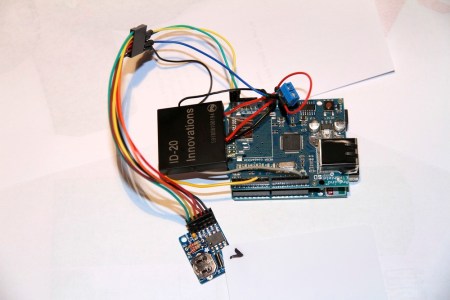
Paul, as he describes himself, is “a student without a big budget,” which might have been part of the inspiration for this hack . Paul wanted to see how much time he was spending under the shower each day, so came up with this monitoring device using the ever-awesome Arduino processor and a RFID tag that many of you are certainly familiar with. One simply waves the tag in front of the reader to start the timer, and waves it again to stop it.
One may not, however, be familiar with “thingspeak” and “weatherspark“, two other important elements of this hack. Thingspeak is “an open application platform designed to enable meaningful connection between things and people,” and was used to interface the weather data on weatherspark with the shower monitor. This was to help figure out if there was a connection between outside temperature and the length of showers taken.
The results of this experiment should be interesting, so hopefully some will be published soon!
[via hackedgadgets]















I’d love to see the results of this experiment. I think I take longer showers when it is cold outside.
hopefully he had the parts laying around from a previous hack. otherwise he just wasted the cash for a water bill builing this, when he could have easily used a waterproof stop watch. Great hack though. Just wish that it wasn’t trying to over-complicate such a simple problem.
I was just gonna say, Sariel, that this doesn’t seem very much like a “small budget” solution to me. “Small budget” to me in this case would be a notepad and a pen. On the other hand, of course, I’m poor enough to have to work for a living, so who cares what I think?
Nice idea, but there’s no point to RFID when you could just hit a button. Or use a sensor to detect when you’ve turned the lever to start the shower. The rest, of course, should be some interesting data. I know I spend longer in the shower when I wake up freezing.
Daily showers are so hard on the environment :/
I def. take a longer shower when it’s cold, but I am more likely to take more then 1 shower per day if it’s hot.
I don’t understand the RFID, as others have said, a button makes more sense…
I also think it would be interesting to measure the volume of the water (both cold and hot sep.) being used, or possibly the outlet water temp–i.e. do you take hotter shower in the winter? colder shower in the summer?
@Dan Fruzzetti
You must be popular w/ the ladies :)
@Aaron
agreed, a notepad and pen would be much easier to come by being a student. :D
Having said that, I do feel this could get better. Perhaps using a water temp sensor would show you more data as in not just water usage but also the load of hot water you use. I’m sure some formula could be created to figure this out.
Showers aren’t hard on the environment people are.
Save the environment don’t pro-create!
/sarcasm
Nice idea and I can see where RFID would be handy for a family you could know which family member is costing the most for water and the gas to heat it.
Come to think of it, maybe I should add RFID to the fridge to see who stands there with the door open the longest, or who left the front door open again trying to heat/cool the outdoors.
If i were to do this i would just measure the consumed water. This is the real thing. And it would cost less than what he has built. Making a diy water volume sensor is not that hard. And it could easily be mounted on the shower.
RFID is contactless, which is useful in wet situations.
@Bogdan – measuring the amount of water is useful because that takes account of the ‘setting’ of the shower – lots of water, powerful jets, for a long time, or gentle shower for short time.
@Dan – turn water on, get wet, turn water off. Soap. Turn water on, rinse, turn water off. Not so bad. Especially if you then harvest the waste water and if you’re using efficient water heating.
@techjoker: get a cheap camera with internal storage and make a simple sensor that detects when the door opens and closes (a piece of conductive surface in each end does the trick).
Then take a picture of the person each time the door opens and record the time it stays open.
If you have an arduino, you could probably do it for $15.
because cameras in the shower room are not creepy, amirite?
Because training yourself with a kitchen timer is too easy.
+1 timer!
It does seem evident (from many projects) that contact with an Arduino may nullify your thinking capacity?
Showers make quite a bit of noise and, conveniently, only when they’re using water.
Kitchen timer…pshhh…How about a watch and piece of paper?